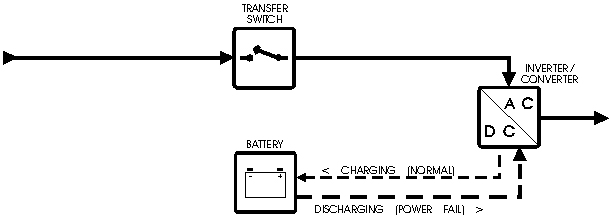|
The line-interactive UPS uses a totally different design than any type of standby UPS. In this type of unit, the separate battery charger, inverter and source selection switch have all been replaced by a combination inverter/converter, which both charges the battery and converts its energy to AC for the output as required. AC line power is still the primary power source, and the battery is the secondary. When the line power is operating, the inverter/converter charges the battery; when the power fails, it operates in reverse.

Block schematic of a line-interactive UPS. Much of the circuitry of a standby UPS has been replaced by a combination inverter/converter unit that charges the battery, inverts its power, and conditions the output.
The main advantage of this design is that the inverter/converter unit is always connected to the output, powering the equipment. This design allows for faster response to a power failure than a standby UPS. The inverter/converter is also normally fitted with circuitry to filter out noise and spikes, and to regulate the power output, providing additional power during brownouts and curtailing output during surges.
The line-interactive UPS is an improved design that is commonly used in units for home and business use, available in sizes up to 3,000 VA or so. It is superior to the standby UPS, but it still has a transfer time, and thus does not provide protection as good as the online UPS.
|
|

